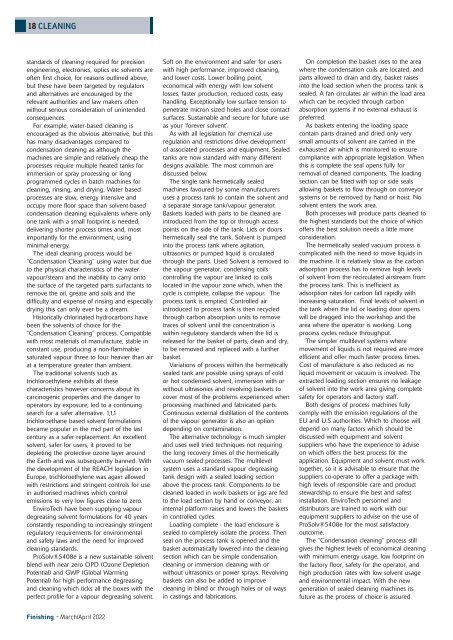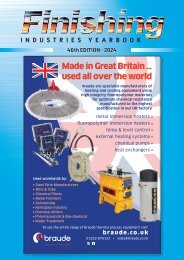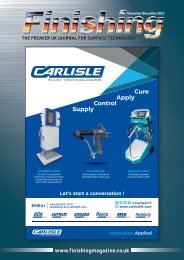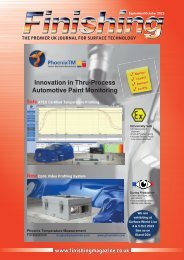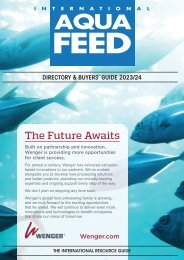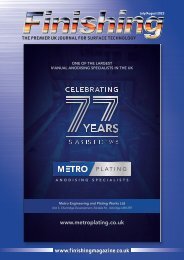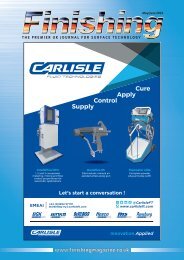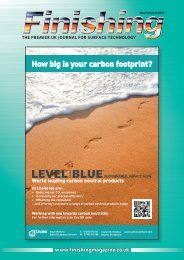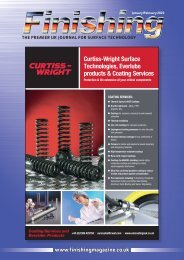Finishing - March-April 2022
Who knew that after coming out of a pandemic, the world could get any worse, but how wrong was everybody. The effects of the war are going to be be huge for industry. Industry that was already under price pressure, but fuel costs now are going to be astronomical. I truly hope that your business survives this latest onslaught. Fair play to all those people volunteering to look after refugees. They have my undying respect and it shows the people of the UK to be a country full of sympathy and humanity. I hope this message is seen from the outside world as I fear that sometimes our leaders may distort how UK citizens really feel. Good luck in the coming months, I think we might need it.
Who knew that after coming out of a pandemic, the world could get any worse, but how wrong was everybody.
The effects of the war are going to be be huge for industry. Industry that was already under price pressure, but fuel costs now are going to be astronomical. I truly hope that your business survives this latest onslaught.
Fair play to all those people volunteering to look after refugees. They have my undying respect and it shows the people of the UK to be a country full of sympathy and humanity. I hope this message is seen from the outside world as I fear that sometimes our leaders may distort how UK citizens really feel.
Good luck in the coming months, I think we might need it.
Create successful ePaper yourself
Turn your PDF publications into a flip-book with our unique Google optimized e-Paper software.
18 CLEANING<br />
standards of cleaning required for precision<br />
engineering, electronics, optics etc solvents are<br />
often first choice, for reasons outlined above,<br />
but these have been targeted by regulators<br />
and alternatives are encouraged by the<br />
relevant authorities and law makers often<br />
without serious consideration of unintended<br />
consequences.<br />
For example, water-based cleaning is<br />
encouraged as the obvious alternative, but this<br />
has many disadvantages compared to<br />
condensation cleaning as although the<br />
machines are simple and relatively cheap the<br />
processes require multiple heated tanks for<br />
immersion or spray processing or long<br />
programmed cycles in batch machines for<br />
cleaning, rinsing, and drying. Water based<br />
processes are slow, energy intensive and<br />
occupy more floor space than solvent-based<br />
condensation cleaning equivalents where only<br />
one tank with a small footprint is needed,<br />
delivering shorter process times and, most<br />
importantly for the environment, using<br />
minimal energy.<br />
The ideal cleaning process would be<br />
“Condensation Cleaning” using water but due<br />
to the physical characteristics of the water<br />
vapour/steam and the inability to carry onto<br />
the surface of the targeted parts surfactants to<br />
remove the oil, grease and soils and the<br />
difficulty and expense of rinsing and especially<br />
drying this can only ever be a dream.<br />
Historically chlorinated hydrocarbons have<br />
been the solvents of choice for the<br />
“Condensation Cleaning” process. Compatible<br />
with most materials of manufacture, stable in<br />
constant use, producing a non-flammable<br />
saturated vapour three to four heavier than air<br />
at a temperature greater than ambient.<br />
The traditional solvents such as<br />
trichloroethylene exhibits all these<br />
characteristics however concerns about its<br />
carcinogenic properties and the danger to<br />
operators by exposure, led to a continuing<br />
search for a safer alternative. 1,1,1<br />
trichloroethane based solvent formulations<br />
became popular in the mid part of the last<br />
century as a safer replacement. An excellent<br />
solvent, safer for users, it proved to be<br />
depleting the protective ozone layer around<br />
the Earth and was subsequently banned. With<br />
the development of the REACH legislation in<br />
Europe, trichloroethylene was again allowed<br />
with restrictions and stringent controls for use<br />
in authorised machines which control<br />
emissions to very low figures close to zero.<br />
EnviroTech have been supplying vapour<br />
degreasing solvent formulations for 40 years<br />
constantly responding to increasingly stringent<br />
regulatory requirements for environmental<br />
and safety laws and the need for improved<br />
cleaning standards.<br />
ProSolv®5408e is a new sustainable solvent<br />
blend with near zero OPD (Ozone Depletion<br />
Potential) and GWP (Global Warming<br />
Potential) for high performance degreasing<br />
and cleaning which ticks all the boxes with the<br />
perfect profile for a vapour degreasing solvent.<br />
Soft on the environment and safer for users<br />
with high performance, improved cleaning,<br />
and lower costs. Lower boiling point,<br />
economical with energy with low solvent<br />
losses, faster production, reduced costs, easy<br />
handling. Exceptionally low surface tension to<br />
penetrate micron sized holes and close contact<br />
surfaces. Sustainable and secure for future use<br />
as your ‘forever solvent’.<br />
As with all legislation for chemical use<br />
regulation and restrictions drive development<br />
of associated processes and equipment. Sealed<br />
tanks are now standard with many different<br />
designs available. The most common are<br />
discussed below.<br />
The single tank hermetically sealed<br />
machines favoured by some manufacturers<br />
uses a process tank to contain the solvent and<br />
a separate storage tank/vapour generator.<br />
Baskets loaded with parts to be cleaned are<br />
introduced from the top or through access<br />
points on the side of the tank. Lids or doors<br />
hermetically seal the tank. Solvent is pumped<br />
into the process tank where agitation,<br />
ultrasonics or pumped liquid is circulated<br />
through the parts. Used Solvent is removed to<br />
the vapour generator, condensing coils<br />
controlling the vapour are linked to coils<br />
located in the vapour zone which, when the<br />
cycle is complete, collapse the vapour. The<br />
process tank is emptied. Controlled air<br />
introduced to process tank is then recycled<br />
through carbon absorption units to remove<br />
traces of solvent until the concentration is<br />
within regulatory standards when the lid is<br />
released for the basket of parts, clean and dry,<br />
to be removed and replaced with a further<br />
basket.<br />
Variations of process within the hermetically<br />
sealed tank are possible using sprays of cold<br />
or hot condensed solvent, immersion with or<br />
without ultrasonics and revolving baskets to<br />
cover most of the problems experienced when<br />
processing machined and fabricated parts.<br />
Continuous external distillation of the contents<br />
of the vapour generator is also an option<br />
depending on contamination.<br />
The alternative technology is much simpler<br />
and uses well tried techniques not requiring<br />
the long recovery times of the hermetically<br />
vacuum sealed processes. The multilevel<br />
system uses a standard vapour degreasing<br />
tank design with a sealed loading section<br />
above the process tank. Components to be<br />
cleaned loaded in work baskets or jigs are fed<br />
to the load section by hand or conveyor, an<br />
internal platform raises and lowers the baskets<br />
in controlled cycles.<br />
Loading complete - the load enclosure is<br />
sealed to completely isolate the process. Then<br />
seal on the process tank is opened and the<br />
basket automatically lowered into the cleaning<br />
section which can be simple condensation<br />
cleaning or immersion cleaning with or<br />
without ultrasonics or power sprays. Revolving<br />
baskets can also be added to improve<br />
cleaning in blind or through holes or oil ways<br />
in castings and fabrications.<br />
On completion the basket rises to the area<br />
where the condensation coils are located, and<br />
parts allowed to drain and dry, basket raises<br />
into the load section when the process tank is<br />
sealed. A fan circulates air within the load area<br />
which can be recycled through carbon<br />
absorption systems if no external exhaust is<br />
preferred.<br />
As baskets entering the loading space<br />
contain parts drained and dried only very<br />
small amounts of solvent are carried in the<br />
exhausted air which is monitored to ensure<br />
compliance with appropriate legislation. When<br />
this is complete the seal opens fully for<br />
removal of cleaned components. The loading<br />
section can be fitted with top or side seals<br />
allowing baskets to flow through on conveyor<br />
systems or be removed by hand or hoist. No<br />
solvent enters the work area.<br />
Both processes will produce parts cleaned to<br />
the highest standards but the choice of which<br />
offers the best solution needs a little more<br />
consideration.<br />
The hermetically sealed vacuum process is<br />
complicated with the need to move liquids in<br />
the machine. It is relatively slow as the carbon<br />
adsorption process has to remove high levels<br />
of solvent from the recirculated airstream from<br />
the process tank. This is inefficient as<br />
adsorption rates for carbon fall rapidly with<br />
increasing saturation. Final levels of solvent in<br />
the tank when the lid or loading door opens<br />
will be dragged into the workshop and the<br />
area where the operator is working. Long<br />
process cycles reduce throughput.<br />
The simpler multilevel systems where<br />
movement of liquids is not required are more<br />
efficient and offer much faster process times.<br />
Cost of manufacture is also reduced as no<br />
liquid movement or vacuum is involved. The<br />
extracted loading section ensures no leakage<br />
of solvent into the work area giving complete<br />
safety for operators and factory staff.<br />
Both designs of process machines fully<br />
comply with the emission regulations of the<br />
EU and U.S authorities. Which to choose will<br />
depend on many factors which should be<br />
discussed with equipment and solvent<br />
suppliers who have the experience to advise<br />
on which offers the best process for the<br />
application. Equipment and solvent must work<br />
together, so it is advisable to ensure that the<br />
suppliers co-operate to offer a package with<br />
high levels of responsible care and product<br />
stewardship to ensure the best and safest<br />
installation. EnviroTech personnel and<br />
distributors are trained to work with our<br />
equipment suppliers to advise on the use of<br />
ProSolv®5408e for the most satisfactory<br />
outcome.<br />
The “Condensation cleaning” process still<br />
gives the highest levels of economical cleaning<br />
with minimum energy usage, low footprint on<br />
the factory floor, safety for the operator, and<br />
high production rates with low solvent usage<br />
and environmental impact. With the new<br />
generation of sealed cleaning machines its<br />
future as the process of choice is assured.<br />
<strong>Finishing</strong> - <strong>March</strong>/<strong>April</strong> <strong>2022</strong>


